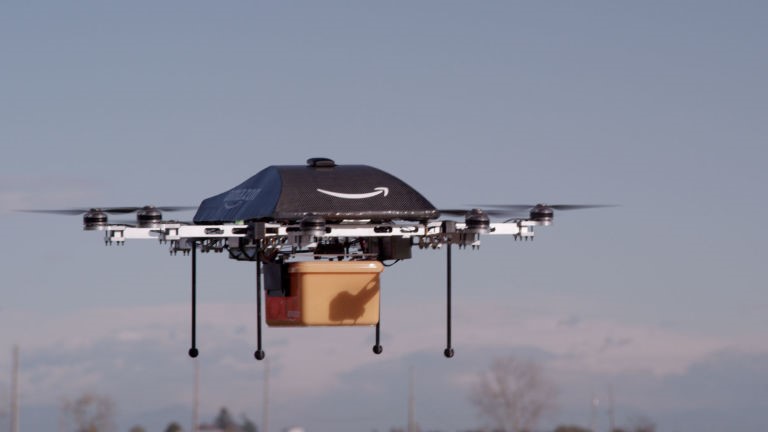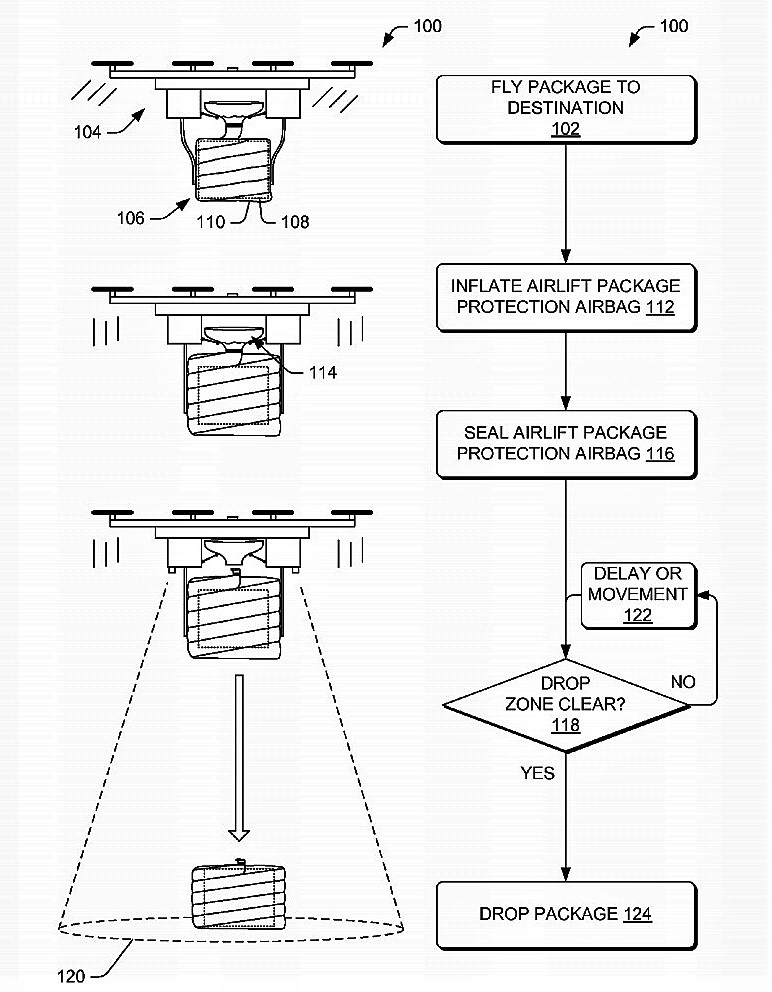Amazon’s Prime Air delivery concept has tantalized potential buyers and sellers since the trial stages in the UK in 2016, but the company has vowed to greatly improve the performance of its air delivery system before undergoing major expansion.
In order to properly expand, Amazon’s team of inventors has created multiple patents, the most recent of which allows for human interaction and an inflatable airbag that secures the delivered package.
Amazon sellers should be excited about the prospect of having an expedited delivery system, but should taper expectations about exactly when and where this delivery system will be fully available.
What exactly is Amazon Prime Air?
Amazon Prime Air is simply a conceptualized drone delivery system where a customer in a rush can have his/her desired item delivered to their house within thirty minutes.
A nearby Prime Air fulfillment center receives a customer’s order and puts it into a box on a conveyor belt, which is then loaded into an electric powered drone. The drone is pushed down an automated track before rising into the sky on its way to deliver the customer his or her desired package.
These drones are fully autonomous, meaning they operate without the aid of an Amazon employee’s guidance using what the company calls “sense and avoid” technology. This technology allows the autonomous drones to “sense” what is going on around it and then “avoid” obstacles on the ground or in the air. The aircraft hovers below 400 feet and has a 15-20 mile range, meaning it can travel up to 10 miles in each direction.
The image provided by Amazon shown below depicts one of many different types of Prime drones.
This one is called “The Big A” for its bulky look:

Amazon plans on designing different types of drones to combat different environments, but cannot currently battle the elements to their liking.
Amazon’s statement on “drones versus weather” is as follows:
“We are currently permitted to operate during daylight hours when there are low winds and good visibility, but not in rain, snow or icy conditions. Once we’ve gathered data to improve the safety and reliability of our systems and operations, we will expand the envelope.”
Other current issues with the delivery system include a limit of only five pounds in the package and a significant lack of available locations.
Originally, this service was only available on a limited trial basis in the UK, but developmental centers have popped up in scattered locations around the United States as well as Austria, France and Israel.
While drone delivery is being tested internationally, sellers should be wary that it could be years before their products are being regularly purchased with Amazon Prime Air.
With ranges that extend to only 15-20 miles thus far, sellers whose products are located in Prime Air fulfillment centers will only be delivered to immediately nearby customers.
What are the new patents?
While Amazon has filed several small patents in an effort to push the envelope on lightning-quick drone delivery, a few of their recent patents stand out as particularly enticing.
One recently approved patent awarded to the company is titled “Human Interaction with Unmanned Aerial Vehicles.”
This will theoretically enable the already fully autonomous drones to detect both audible and visible gestures from the customer it is delivering a package to, allowing the customer to tell the drone where it should drop the package.
As PYMNTS.com says:
By interacting with a database of stored gestures, the drone can match the customer’s action and adjust its propulsion, trajectory, and speed to complete its task based on the customer’s request.
While in trial runs, users needed to have their own miniature helipad-esque landing area available for the drone. Now users should be able to simply say or point to where they would like the aircraft to land.
Another patent that could be of great interest to sellers is a newly filed “airlift package protection airbag,” which is exactly what it sounds like.
As proposed, the airbag would be placed around whatever package is being sent, protecting it from outside harm that may be unavoidable for the drone. This could ideally be the first step in helping packages get through rainy or snowy climates unscathed.
This image provided by USPTO shows a simple flowchart of Amazon’s airbag inflation plan:

Packaged Amazon items typically use some type of internal packaging in order to prevent damage to the containers within. But with these packages outside of shipping trucks, they are exposed to more elements that could possibly damage the packaging and contents within.
This patent has to be a reaction to problems that occurred during trial runs. Customers’ items were most likely arriving in poor condition or with slight damages during testing, otherwise Amazon would not have made it imperative to design such an invention.
How will Amazon Prime Air help sellers?
The Amazon Prime Air concept has been only in the works for around two years, having only been in use on a very small scale. However, government agencies in the United States recently began pushing for the utilization of drones to occur sooner than later.
The head of the Federal Aviation Administration’s drone-integration office, Earl Lawrence, has said:
“[Drone delivery is] a lot closer than many of the skeptics think… They are getting ready for full-blown operations.”
With countries like the UK, Singapore, Australia and Israel already using these drone delivery systems (albeit not frequently), the US government has pushed for quicker approvals, having approved over 10 FAA pilot programs that are scheduled to begin as early as May.
For sellers of small items weighing under five pounds, this has to be absolutely thrilling news.
Ideally, this signals the end of worrying about whether your package will be delivered to your customer and whether it will be on time or not.
This timely delivery system could help sellers sell their products more frequently, as customers will be more inclined to make purchases if they arrive moments later.
It also will help sellers incur less account suspensions or penalties from late deliveries.
Amazon is doing everything they can in order to speed up the implementation of the Prime Air concept, even pairing with companies like Google and General Electric to make what PYMNTS.com calls a, “low-altitude traffic-control network, which will be funded and operated by more than 10,000 drone-related companies and 70,000 registered commercial aerial vehicles.”
Unfortunately, larger items cannot be transported via drone yet, but sellers can rest assured that Amazon is doing everything in its power to increase the weight their electric-powered air crafts can carry.
Sellers will likely be frustrated with the limited amount of consumers who can actually order their products at first, but once more Prime Air fulfillment destinations pop up, the consumer market will expand massively.